 Image search results - "city" Image search results - "city" |

Aizu-Wakamatsu City Hall 会津若松市役所
|
|

Ritto City Hall. MAP
|
|
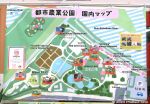
Adachi City Urban Agricultural Park is a riverside park at the corner of Arakawa River and Shin-Shibakawa River growing many varieties of cherry blossoms including those from Washington, DC planted here in 1981-82.
|
|
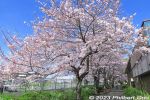
The most prominent cherry blossoms from Washington, DC are the Somei-Yoshino cherry blossoms named "America." They bloom in late March along Shin-Shibakawa River.
|
|
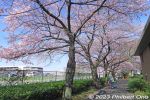
These Somei-Yoshino "America" cherry blossoms are right behind the park's Visitors' Center. The America trees stretch along Shin-Shibakawa River for a few hundred meters, one of the park's major cherry blossom clusters.
|
|
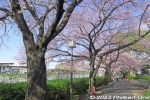
I visited one or two days before peak bloom, so they don't look as fluffy or full. The weather forecast was for cloudy or rainy skies after this day.
|
|
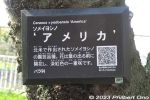
"America" cherry blossom tree ID tag on a sakura tree.
|
|
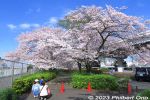
This was one in full bloom.
|
|
|
|
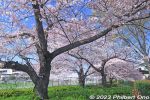
"America" cherry trees in Adachi, Tokyo.
|
|
|
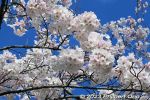
"America" cherry blossoms in full bloom.
|
|
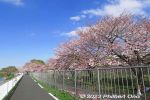
"America" Somei-Yoshino cherry blossoms decorated the Shin-Shibakawa riverbank from here. They were in parallel with a riverside walking/cycling path on the left.
|
|
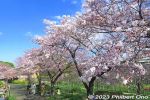
These were still one or two days before peak bloom.
|
|
|
|
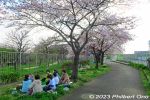
Hanami picnic under the America cherry blossoms. Feeling the Spirit of America.
|
|
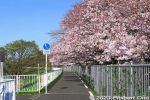
A long cycling path goes along Shin-Shibakawa River and the America cherry blossoms.
|
|
|
|
|
|
|
|
|
|
|
|
|
|
|
|
|
|
|
|
|
|
|
|
|
|
|
|
|
|
|
|
|
|
|
|
|
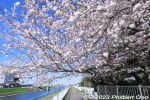
This is the end of the "America" Somei-Yoshino cherry blossoms.
|
|
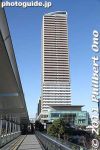
Gifu City Tower 43 is connected to JR Gifu Station with an upper level walkway.
|
|
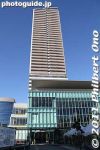
The lower floors have shops and restaurants. Upper floors are condominiums. The 43rd floor at the top is a lookout deck and restaurant.
|
|

Shops inside Gifu City Tower 43.
|
|
|
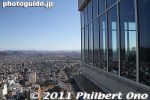
Top floor is a lookout deck operated by the city. Free admission. Elevator takes 45 sec. to get to the top.
|
|

Gifu City Tower 43 lookout deck looking east.
|
|

View of Mt. Kinkazan (Gifu Castle) from Gifu City Tower 43.
|
|
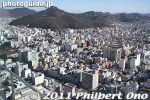
View of Mt. Kinkazan (Gifu Castle) from Gifu City Tower 43.
|
|
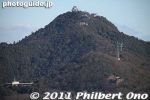
View of Mt. Kinkazan (Gifu Castle) from Gifu City Tower 43.
|
|
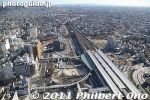
View of JR Gifu Station from Gifu City Tower 43.
|
|

View of JR Gifu Station from Gifu City Tower 43.
|
|
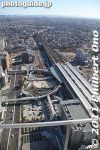
View of JR Gifu Station from Gifu City Tower 43.
|
|
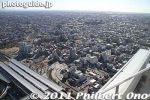
View of JR Gifu Station from Gifu City Tower 43, looking toward Nagoya.
|
|
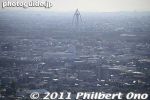
Arch Tower in Ichinomiya, Aichi.
|
|
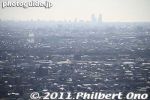
Nagoya as seen from Gifu City Tower 43.
|
|
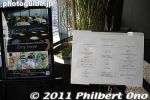
Entrance to a restaurant.
|
|
|
|
|
|
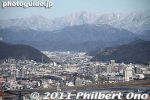
Nagara River
|
|
|
|
|
|
|
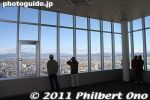
There is another lookout deck on the west side.
|
|

View of Ibuki mountain range from Gifu City Tower 43.
|
|
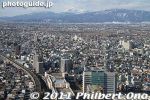
Gifu and Ibuki mountains.
|
|
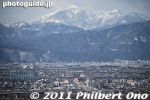
Mt. Ibuki as seen from Gifu City Tower 43.
|
|
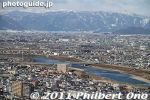
Nagara River
|
|
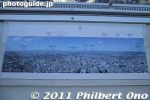
Guide to scenic points.
|
|

This is the old Imazu Port building. It was a two-story building with a small restaurant on the 2nd floor. Ironically, it had no enclosed interior space for passengers.
|
|

Lake Biwa from Imazu shore. Mt. Ibuki in the distance.
|
|

Chikubushima as seen from Imazu Port
|
|

At the end of Imazu Port's dock is a lantern which is a song monument.
|
|

Imazu's main lakeshore road leads to more tourist sights.
|
|

Lakeshore road in winter
|
|
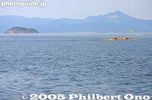
Chikubushima and Mt. Ibuki as seen from Imazu.
|
|

Imazu in winter
|
|

Imazu has a pebble beach. Some sand as well.
|
|

On the shore is a small stone wall and foundation, the remains of the Kaga Clan's magistrate's office. Imazu was within the Kaga domain (centering on Ishikawa Prefecture) during the Edo Period.
|
|
|
|
|

Black kite going fishing トビ
|
|
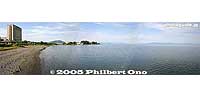
Lake Biwa shore in Imazu, with a boat landing in the distance
|
|

Imazu also has a few buildings designed by William Merrell Vories like this former bank building in Imazu, Shiga Now a coffee shop and exhibition space. MAP
|
|

Inside the former bank building
|
|
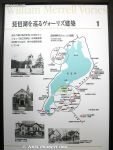
William Merrell Vories architecture map of Shiga.
|
|

Former bank building
|
|
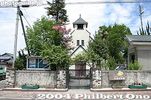
Imazu Church, designed by William Merrell Vories. Next to the former bank building also designed by Vories.
|
|

Sumiyoshi Jinja Shrine 住吉神社
|
|

Road from Imazu Port to Omi-Imazu Station.
|
|

In winter, road toward Imazu Port
|
|

Omi-Imazu Station on JR Kosei Line, East Exit
|
|

Inside Omi-Imazu Station
|
|

In front of Omi-Imazu Station, East Exit
|
|
|

Omi-Imazu Station, west exit has bus stops for local buses.
|
|

Omi-Imazu station, west side
|
|

Omi-Imazu Station, west side
|
|
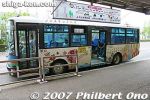
Bus at Omi-Imazu Station with localized design.
|
|

Shopping arcade on the west side of Omi-Imazu Station
|
|

Shopping arcade
|
|

Scenic water on sunny day, Takashima
|
|
|

Gifu Castle on Mt. Kinkazan as seen from the Nagara River. In the foreground is Nagaragawa Onsen Spa. Commanding a strategic viewpoint of the entire city, Mt. Kinkazan must have looked like an obvious place to build a castle.
|
|

Gifu Castle on Mt. Kinkazan as seen from the Tokaido Line train. The castle can still be seen from many kilometers away. It is one of the symbols of Gifu city.
|
|

Gifu Castle on Mt. Kinkazan and ropewayA convenient ropeway makes it a snap to visit the castle.
|
|

Gifu Castle ropeway boarding area
|
|

Tenka Daiichi-no-mon GateThe first gate toward the castle tower.
|
|

Former horseback riding grounds
|
|

Remains of the Ninomaru-mon Gate
|
|

Path to the castle towerGo up the left steps to proceed to the tower.
|
|

Gifu Castle towerGifu Castle was originally called Inabayama Castle. Its known history starts from the 16th century with Lord Saito Dosan. Oda Nodunaga later took over the castle in 1567. He also renamed Inaba city as "Gifu."
Nobunaga left Gifu Castle and moved to Azuchi Castle in Shiga Pref. His sons took over Gifu Castle. Right before the Battle of Sekigahara, Tokygawa Ieyasu's forces attacked Gifu Castle which burned to the ground on Aug. 23, 1600.
The current castle tower was reconstructed in 1954.
|
|
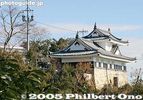
Gifu Castle Museum
|
|

Path to Gifu Castle tower
|
|

Castle tower
|
|

Low-angle view of castle tower
|
|

Castle tower base
|
|

Castle clock
|
|

Inside the castle towerIt is a museum inside the tower.
|
|

Castle tower observation deckMarvelous views of Gifu city can be had.
|
|
|
|
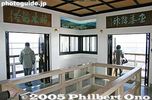
Top floor of castle tower
|
|

Inside Gifu Castle Museum
|
|

Gifu Castle MuseumIt is located on the site of a storehouse.
|
|

Another observation deck
|
|

Ropeway station
|
|

Outdated photo: Arriving Imazu Port. This old port building was replaced by new building in March 2020. MAP
|
|

Outdated photo: Red flame monument for Biwako Shuko no Uta song 琵琶湖周航の歌 歌碑
|
|

Outdated photo: Waiting lounge at Imazu Port in winter.
|
|
|

Song museum's listening station where you can listen to many cover versions of the Lake Biwa Rowing Song recorded by Japanese singers and groups.
|
|

List of cover versions by singers like Miyako Harumi, Kobayashi Akira, Watari Tetsuya, Baisho Chieko, Frank Nagai, and more.
|
|
|
|

Made of wood. The seats do not move. It is an obsolete racing boat.
|
|

Water lilies from the Niigata home of Chiaki Yoshida who composed the melody of Lake Biwa Rowing Song. From the original plant that Chiaki planted.
|
|
|

Water lilies
|
|

In the old Imazu Port building, snowy seats in winter.
|
|
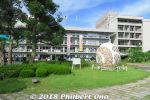
Maizuru City Hall is next to Maizuru Brick Park.
|
|
|
|
|
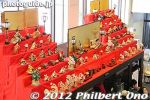
More dolls above the entrance.
|
|
|
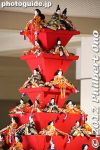
The top dolls are actually screwed on to the pyramid so they won't fall during an earthquake.
|
|
|
|
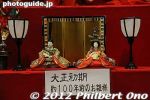
Antique hina dolls were also displayed. These are from the 1920s.
|
|
|
|
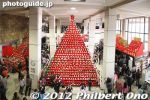
Konosu Bikkuri Hina Matsuri doll festival in Konosu, Saitama.
|
|
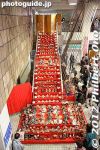
This stairway was also filled with dolls.
|
|
|
|
|
|
|
|
|
|
|
|
|
|
|
|

We could go up to the 2nd floor which was also lined with dolls.
|
|
|
|
|
|
|
|
|
|
|
|
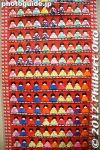
Origami hina dolls
|
|

They also sold local products like honey.
|
|
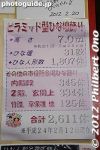
Numeric data on the hina doll pyramid. The pyramid is 7 meters high, has 31 steps and 1,807 dolls.
|
|
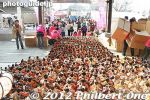
Front porch again.
|
|
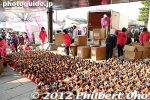
The dolls on the porch are displayed until 3:30 pm. They are now putting away the dolls.
|
|
|
|
|
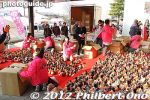
They put away the dolls in no time.
|
|
|

Local mascot.
|
|
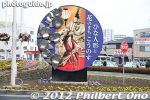
Hina doll monument in front of JR Konosu Station.
|
|
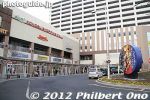
Elumi Konosu Shopping Mall in front of Konosu Station.
|
|

Inside Elumi Konosu Shopping Mall.
|
|
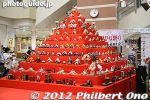
Another festival site is the Elumi Konosu Shopping Mall in front of Konosu Station. They have a smaller pyramid of dolls and stage entertainment on the 1st floor's Central Court.
|
|
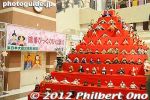
Elumi Konosu Shopping Mall also holds a hina matsuri doll festival with a smaller pyramid.
|
|
|
|
|
|
|
|
|
|
|
|
|
|
|
|
|
|
|
|
|
|
|

Entertainment schedule in front of the doll pyramid.
|
|

Hina Doll Festival schedule.
|
|
|
|
|
|
|
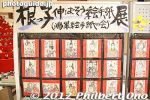
Postcards
|
|
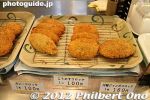
Good place to pick up something to eat at the food court.
|
|

Komae City Hall 狛江市役所
|
|
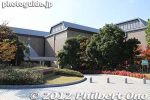
The Shunan City Museum of Art and History is a nice, modern museum. A short bus ride from JR Tokuyama Station.
|
|
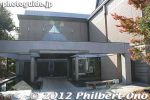
Entrance to Shunan City Museum of Art and History. Admission 200 yen.
|
|
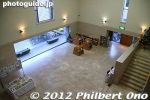
Lobby of Shunan City Museum of Art and History.
|
|
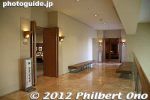
Second floor of Shunan City Museum of Art and History.
|
|
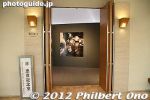
Shunan Museum of Art and History has a large exhibition room dedicated to photographer Tadahiko Hayashi (1918-1990).
|
|
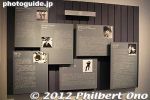
Tadahiko Hayashi was from Tokuyama and his family donated all his photos and camera equipment to this museum.
|
|
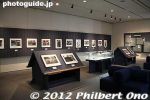
Inside the Hayashi Tadahiko exhibition room. Quite spacious. It also has a small video theater interviewing him and showing him at work.
|
|
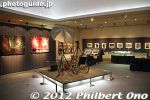
Entrance to the Hayashi Tadahiko exhibition room. Hayashi is noted for his photos of the post-war years when Japan was poor and devastated by the war.
|
|

Hayashi continued to shoot photos even while on a wheelchair during his final years. His wheelchair and camera equipment (used for his Tokaido Road series) are displayed in the center of the room. He used Contax cameras.
|
|
|
|

Hayashi's photos of parentless and dirty street kids smoking and repatriated Japanese soldiers are important visual records of those years.
|
|
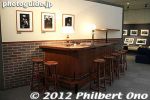
Hayashi was also famous for his portraits of famous Japanese novelists. This is a replica of a bar which was a backdrop for one of his famous portraits of Osamu Dazai.
|
|
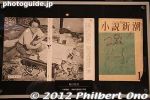
Another famous portrait by Hayashi is this one of novelist Sakaguchi Ango. Talk about writer's block. Instead of having a Delete key, he just literally trashed his mistakes.
|
|
|
|

Also on the 2nd floor is a room showing the history of Tokuyama.
|
|
|
|
|
|

Higashi-Omi City Hall
|
|

Higashi-Omi City Hall
|
|

Sister city monument at Higashi-Omi City Hall.
|
|
|
|